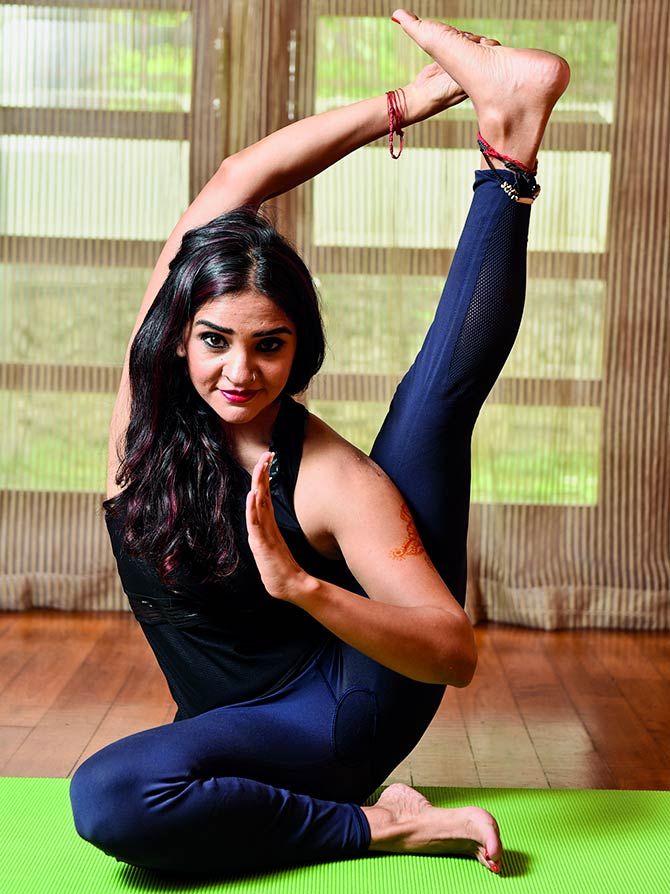The book Yoga Shakti by Shalini Menon aims to help you address your weakness and become fit and strong inside out.

Photograph: Kind courtesy Yoga Shakti by Shalini Menon
Yoga, it seems, has solutions for all your problems.
From backache to stress, it even has asanas to help you get rid of negativity.
In the book Yoga Shakti: Awaken Your Own Power by Malaysia-based Shalini Menon discusses how yoga helped her become fit, regain power and achieve self-realisation.
The book, released by MP Shashi Tharoor has a chapter on how to cope with 'Negativity Bias.'
Presenting an excerpt from the book:
Negativity Bias
This is conscious work as the 'negativity bias' runs deep in all of us.
Negativity bias is an accepted human phenomenon where negative experiences tend to exert a greater psychological impact on us than positive experiences of the same magnitude.
Scientists say that it is an evolutionary adaptation that we react to bad or dangerous things more quickly and persistently than to good things.
It suggests that our minds are hardwired to be naturally skewed towards negativity, as a result of which we tend to remember more insults than praise -- the one person who didn't congratulate us though a 100 other people did, the one girl who was mean to us in school more than 20 years ago though we aren't in contact with that person now.
This can have a devastating effect on our emotions and our lives, as it gets integrated into our belief systems and we just live and act out of it.
We have to develop the capacity to 'see' the negative workings of the mind, the same patterns of judgment -- this is bad, he is evil, she is conniving, money is the root of evil.
We may have self-defeating thoughts -- I am never going to be successful, I don't have what it takes to be wealthy, I am fated to be disappointed in love.
We may even develop a victim mentality -- he did this to me, I am unsuccessful today because my parents never loved me, if I were more beautiful I would be happier ... the list goes on.
Only when we become conscious of the working of the mind can we take back our power to shift our perspective and break the loop of thought, think differently and thus, bring about a change in the state of our minds and, eventually, our lives.
As is our inner world so is our outer world. All the work is in our hearts -- to keep it open in the face of resistance, heartbreak and grief, and to be able to receive life as it unfolds.
That is the tapas (intense effort), that is the journey, that is the yoga!
Practice
What patterns block your happiness?
What do you find most hard to let go of, though you know it is not good for you?
What is it you fear the most if you let go of that pattern?
What are you compromising by holding on to the situation?
Is it your dignity? Your self-respect? Your sanity? Your lifestyle?
Asanas: Bound Asanas
In life, we bind ourselves consciously or unconsciously through our thoughts and actions.
Ultimately, in the yearning for freedom and liberation, we have to unlock and release ourselves.
We embody that in our asana practice with a bound sequence.
Baddha Padmasana: Bound Lotus

Sit with your legs stretched out in front of you.
Externally rotate your right hip, bend your right leg, catch hold of your right foot with both hands and carefully bring the heel of your right foot to the left hip crease.
Very carefully, do the same with your left foot. Since a sideways pulling of the shin is possible here (which can potentially cause an injury), it is advisable to learn the lotus asana under the supervision of an experienced teacher.
For the bound position, it is important to try and get both heels as close to your hip as possible.
This results in a closely bound lotus and allows you to open your shoulders and take your arms behind your torso to hold your toes.
First, take one arm behind your body and hold your big toe, then lean towards the other side to hold the other big toe.
Baddha Parsvakonasana: Bound Lateral Angle Pose

Keep your feet wide apart. Turn your right leg out to the right.
Bend your right knee until your knee is directly over your right heel.
Slide your left foot away as much as needed so that you can lower your right buttock down to be in line with your right knee.
Lean to the right and place your right palm on the floor besides your right foot.
Take your left arm over your ear and lengthen the side body.
This is parsvakonasana or the lateral angle position.
From here, as you exhale, lower your right shoulder below your right thigh, internally rotate your right shoulder, bend your right elbow and reach towards your right outer thigh/ hip with your right hand.
Now externally rotate your left shoulder and take your left arm back and down.
Catch your left wrist with your right hand if possible. Otherwise use a strap and hold one side of the strap in each hand.
Excerpted from the book Yoga Shakti written by Shalini Menon and published with the kind permission of publishers, Niyogi Books.











